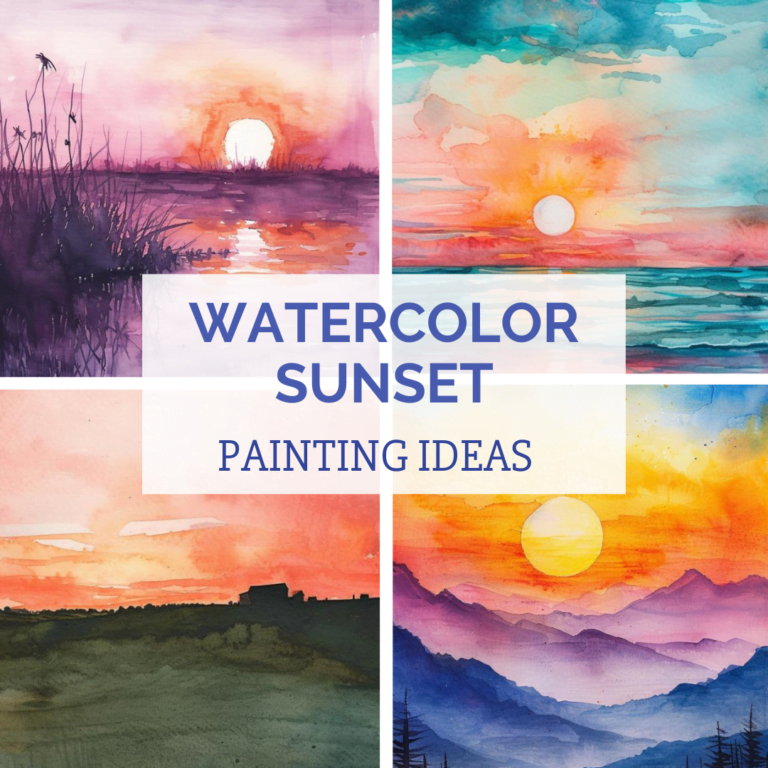Last Updated on January 31, 2025 by Dee
Capturing the ethereal beauty of a sunset in watercolor can be both a thrilling challenge and a deeply rewarding experience for artists of all skill levels. In this post, we’re diving into the realm of the watercolor sunset, a subject that offers endless possibilities for creativity, emotion, and expression. Grab our free watercolor stencils at the end of this post!
Read on for essential tips for painting watercolor sunsets and get inspired with our curated collection of 30 stunning watercolor sunset painting ideas. Let’s harness the beauty of the fading light and translate it onto paper, creating works that speak to the soul.
Table of Contents
Watch this easy Sunset Painting Tutorial for Beginners 👇🏻
30 Watercolor Sunset Painting Ideas
Dive into our curated collection of watercolor sunset paintings, a source of inspiration for artists at any level. This selection highlights the versatility of watercolors in capturing the breathtaking beauty of sunsets, from tranquil to vibrant scenes. It serves as a testament to the expressive power of this medium and a starting point for your own explorations. Let these pieces spark your creativity and guide you in creating your own watercolor sunset masterpieces.
How to Paint an Easy Watercolor Sunset for Beginners
Creating a watercolor sunset is a fantastic way to begin your journey with watercolors. Here’s a simple, step-by-step guide designed for beginners to help you paint your own sunset with ease. Or you can watch this great watercolor sunset tutorial!
1. Gather Your Supplies: You will need watercolor paper, a basic set of watercolor paints, a couple of brushes (a large flat brush and a round brush), a jar of water, and some paper towels.
2. Sketch the Horizon: Lightly draw a straight line across your paper where you want the horizon to be. This will separate the sky from the land or water in your painting.
3. Wet the Paper: Using your large flat brush, evenly wet the area above the horizon line with clean water. This technique, called wet-on-wet, allows the colors to blend smoothly.
4. Start with Light Colors: Pick a light yellow and gently apply it near the horizon line. This will be the lightest part of your sky.
5. Add Warm Colors: Gradually introduce orange and then red above the yellow, blending each color into the next. Keep the colors lighter near the horizon and darker as you move up.
6. Blend in Cool Colors: At the top of the sky, blend in some purple or deep blue, merging it into the red to mimic the transition of colors in a real sunset.
7. Paint the Water/Land: If your sunset includes water, mimic the colors of the sky in a horizontal direction below the horizon. For land, a simple dark silhouette of hills or trees can work wonderfully.
8. Add Clouds (Optional): With a clean, slightly damp brush, lift off some paint where you want clouds to be. You can also add soft touches of pink or orange to suggest clouds reflecting the sunset’s colors.
9. Finishing Touches: Once the painting is dry, you can add details such as birds, a sun disk, or further define the clouds with a smaller brush.
10. Let It Dry: Allow your masterpiece to fully dry. Watercolor can look different when it’s wet, so give it time to settle and dry to see the final effect.
Remember, watercolor is a medium that can be beautifully unpredictable. Embrace the blends and transitions that occur naturally, and enjoy the process of creating your own watercolor sunset!

Art Supplies Needed to Paint a Watercolor Sunset
To embark on your journey of painting a captivating watercolor sunset, having the right supplies is essential.
**This page may contain affiliate links to products I have used or recommend. If you purchase something from this page, I may receive a small percentage of the sale at no extra cost to you.**
Here’s a list of art supplies you’ll need to create your masterpiece:
- Watercolor Paper: Opt for high-quality, heavy-weight (at least 140 lb or 300 gsm) watercolor paper to avoid warping. Cold press paper is ideal for beginners due to its slightly textured surface, which is forgiving and can handle a lot of water.
- Watercolor Paints: A basic set of watercolor paints can get you started. For sunsets, ensure you have a range of yellows, oranges, reds, purples, and blues. Artist-grade paints will provide richer colors and better fading resistance than student-grade paints.
- Brushes: A variety of brushes will help achieve different effects. At a minimum, have a large flat brush for washes and a round brush for details. A mop brush can be handy for large, wet areas, and a fine-tipped brush is excellent for small details.
- Palette: You’ll need a palette for mixing your paints. Many watercolor sets come with a palette, or you can use a white ceramic plate.
- Water Container: Have a jar or cup of clean water for rinsing your brushes. Some artists use two containers: one for rinsing dirty brushes and one for clean water to mix with paints.
- Paper Towels or a Rag: These are essential for blotting your brushes to control the amount of water and paint, correcting mistakes, or creating texture.
- Masking Tape: Use masking tape to secure your paper to a board and to create clean edges around your painting if desired.
- Pencil and Eraser: A soft pencil (2B or higher) is perfect for lightly sketching your composition before painting. Use a kneaded eraser to gently remove pencil lines without damaging the paper.
- Masking Fluid (Optional): Masking fluid can be applied to areas of the paper you wish to keep white. It’s especially useful for preserving the lightest parts of a sunset or creating the effect of sun rays.
- Board or Support: To keep your paper flat while painting, especially for wet techniques, tape your watercolor paper to a flat board.
- Spray Bottle (Optional): A fine mist spray bottle can be useful for wetting the paper evenly or reactivating dry paints on your palette.
Gathering these supplies will ensure you have everything needed to paint a beautiful watercolor sunset, allowing you to focus on the creative process and explore the nuances of this captivating subject.
Tips and Tricks for Using Watercolor
Watercolor painting can be as challenging as it is rewarding. Here are some essential tips and tricks to help you master the medium and bring your creative visions to life:
1. Work from Light to Dark: Unlike other painting mediums, watercolors are transparent, so it’s important to start with the lightest colors and gradually layer darker shades over them. Preserve the white of the paper for the lightest areas, as white paint is seldom used in traditional watercolor techniques.
2. Embrace the Water: The amount of water you use can dramatically affect the look of your painting. More water will create lighter, more transparent washes, while less water results in darker, more saturated colors. Experiment with different ratios to achieve the desired effect.
3. Use Quality Materials: High-quality watercolor paper, paints, and brushes can significantly impact your final piece. Watercolor paper should be thick and absorbent to handle wet washes without warping. Artist-grade paints provide more vibrant, lasting colors than student-grade paints.
4. Master Wet-on-Wet and Wet-on-Dry: The wet-on-wet technique involves applying paint to a wet surface for soft color blends, ideal for backgrounds and skies. Wet-on-dry, applying paint to a dry surface, offers more control and is perfect for details and textures.
5. Keep a Paper Towel Handy: A paper towel can be used to dab your brush to control moisture or lift paint off the paper to correct mistakes or create highlights.
6. Preserve Whites with Masking Fluid: Masking fluid can be applied to areas you wish to keep white before you start painting. Once the painting is dry, the fluid can be rubbed away to reveal the untouched paper beneath.
7. Layer Colors for Depth: Build up colors with multiple layers (glazes) to add depth and richness to your painting. Allow each layer to dry completely before applying the next to prevent unwanted blending.
8. Practice Color Mixing: Get familiar with mixing your colors on a palette or directly on the paper. Understanding how colors interact is key to creating vibrant and natural-looking paintings.
9. Be Patient: Allow the paint to dry naturally for smooth, consistent results. Rushing the drying process with heat or airflow can cause unwanted textures or blending.
10. Embrace Imperfections: The beauty of watercolor lies in its unpredictability and the unique textures it creates. Don’t be afraid of mistakes; they can add character and originality to your work.
Grab the Free Printable Stencils for Watercolor HERE (below)!
To access the free in-post printables for this post, you’ll just need to create a free account or login with the Grow.me tool. Then, confirm by email and refresh the page and ALL my free printables will automatically unlock in every post!
Other articles you may enjoy…




































































Thank You!!
My pleasure! x